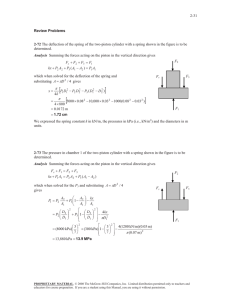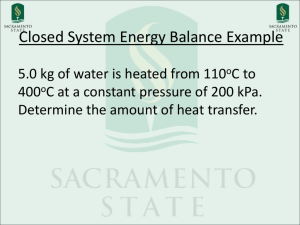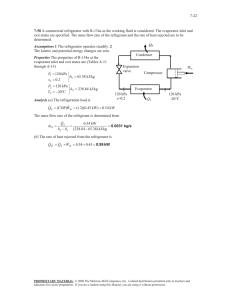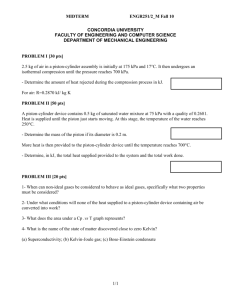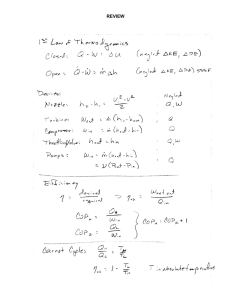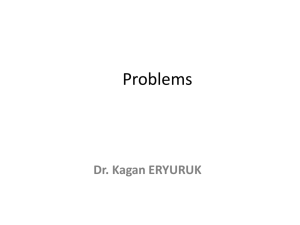Thermodynamics Problems: Basic Concepts
advertisement
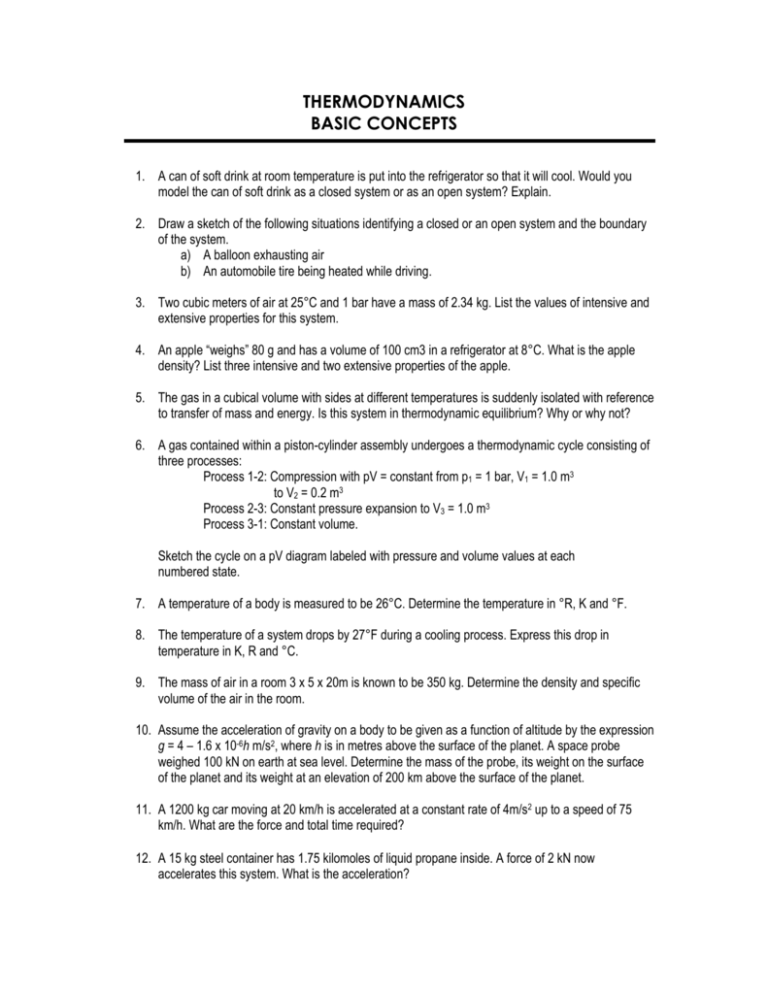
THERMODYNAMICS BASIC CONCEPTS 1. A can of soft drink at room temperature is put into the refrigerator so that it will cool. Would you model the can of soft drink as a closed system or as an open system? Explain. 2. Draw a sketch of the following situations identifying a closed or an open system and the boundary of the system. a) A balloon exhausting air b) An automobile tire being heated while driving. 3. Two cubic meters of air at 25°C and 1 bar have a mass of 2.34 kg. List the values of intensive and extensive properties for this system. 4. An apple “weighs” 80 g and has a volume of 100 cm3 in a refrigerator at 8°C. What is the apple density? List three intensive and two extensive properties of the apple. 5. The gas in a cubical volume with sides at different temperatures is suddenly isolated with reference to transfer of mass and energy. Is this system in thermodynamic equilibrium? Why or why not? 6. A gas contained within a piston-cylinder assembly undergoes a thermodynamic cycle consisting of three processes: Process 1-2: Compression with pV = constant from p1 = 1 bar, V1 = 1.0 m3 to V2 = 0.2 m3 Process 2-3: Constant pressure expansion to V3 = 1.0 m3 Process 3-1: Constant volume. Sketch the cycle on a pV diagram labeled with pressure and volume values at each numbered state. 7. A temperature of a body is measured to be 26°C. Determine the temperature in °R, K and °F. 8. The temperature of a system drops by 27°F during a cooling process. Express this drop in temperature in K, R and °C. 9. The mass of air in a room 3 x 5 x 20m is known to be 350 kg. Determine the density and specific volume of the air in the room. 10. Assume the acceleration of gravity on a body to be given as a function of altitude by the expression g = 4 – 1.6 x 10-6h m/s2, where h is in metres above the surface of the planet. A space probe weighed 100 kN on earth at sea level. Determine the mass of the probe, its weight on the surface of the planet and its weight at an elevation of 200 km above the surface of the planet. 11. A 1200 kg car moving at 20 km/h is accelerated at a constant rate of 4m/s2 up to a speed of 75 km/h. What are the force and total time required? 12. A 15 kg steel container has 1.75 kilomoles of liquid propane inside. A force of 2 kN now accelerates this system. What is the acceleration? 13. Express a pressure gage reading of 35 psi in absolute pascal. (Assuming Patm = 100 kPa). 14. A hydraulic lift has a maximum fluid pressure of 500 kPa. What should the piston cylinder diameter be so it can lift a mass of 850 kg? 15. Blue manometer fluid of density 925 kg/m3 shows a column height difference of 6cm vacuum with one end attached to a pipe and the other end open to P = 101 kPa. What is the absolute pressure in the pipe? 16. An object whose mass is 400 kg is located at an elevation of 25 m above the surface of the earth. For g = 9.78 m/s2, determine the potential energy of the object, in kJ, relative to the surface of the earth. 17. A 10 kg body falls from rest, with negligible interaction with its surroundings. Determine its velocity after it falls 5m. 18. A piston motion moves a 25 kg hammerhead vertically down 1 m from rest to a velocity of 50 m/s in a stamping machine. What is the change in total energy of the hammerhead? 19. A 0.8 lbm object traveling at 200 ft/s enters a viscous liquid and is essentially brought to rest before it strikes the bottom. What is the increase in internal energy, taking the object and the liquid as the system? Neglect the potential energy change. 20. A 1500 kg vehicle traveling at 60 km/h collides head on with a 1000 kg vehicle traveling at 90 km/h. if they come to rest immediately after impact, determine the increase in internal energy, taking both vehicles as the system.
